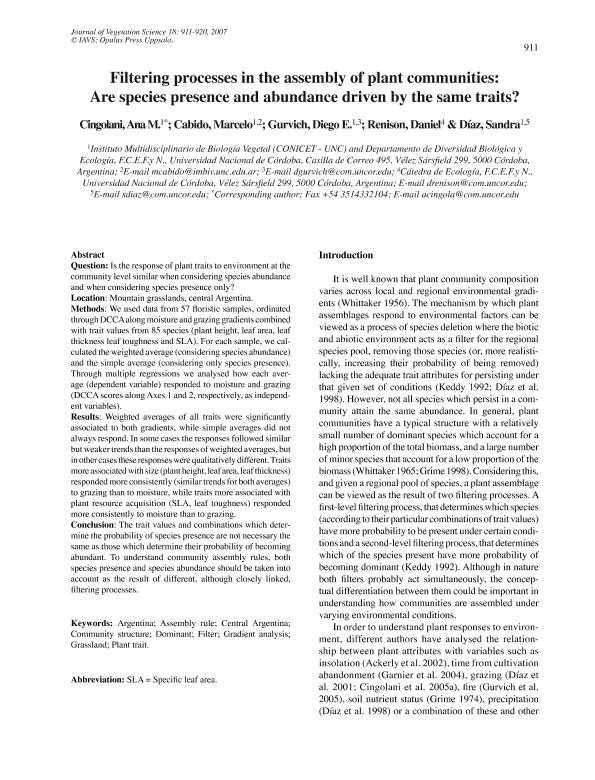Mostrar el registro sencillo del ítem
dc.contributor.author
Cingolani, Ana María

dc.contributor.author
Cabido, Marcelo Ruben

dc.contributor.author
Gurvich, Diego Ezequiel

dc.contributor.author
Renison, Daniel

dc.contributor.author
Díaz, Sandra Myrna

dc.date.available
2018-02-20T15:25:01Z
dc.date.issued
2007-12
dc.identifier.citation
Cingolani, Ana María; Cabido, Marcelo Ruben; Gurvich, Diego Ezequiel; Renison, Daniel; Díaz, Sandra Myrna; Filtering processes in the assembly of plant communities: Are species presence and abundance driven by the same traits?; Wiley Blackwell Publishing, Inc; Journal of Vegetation Science; 18; 6; 12-2007; 911-920
dc.identifier.issn
1100-9233
dc.identifier.uri
http://hdl.handle.net/11336/36805
dc.description.abstract
Question: Is the response of plant traits to environment at the community level similar when considering species abundance and when considering species presence only? Location: Mountain grasslands, central Argentina. Methods: We used data from 57 floristic samples, ordinated through DCCA along moisture and grazing gradients combined with trait values from 85 species (plant height, leaf area, leaf
thickness leaf toughness and SLA). For each sample, we calculated the weighted average (considering species abundance) and the simple average (considering only species presence). Through multiple regressions we analysed how each average
(dependent variable) responded to moisture and grazing (DCCA scores along Axes 1 and 2, respectively, as independent variables). Results: Weighted averages of all traits were significantly associated to both gradients, while simple averages did not
always respond. In some cases the responses followed similar but weaker trends than the responses of weighted averages, but in other cases these responses were qualitatively different. Traits more associated with size (plant height, leaf area, leaf thickness) responded more consistently (similar trends for both averages)
to grazing than to moisture, while traits more associated with plant resource acquisition (SLA, leaf toughness) responded more consistently to moisture than to grazing. Conclusion: The trait values and combinations which determine
the probability of species presence are not necessary the same as those which determine their probability of becoming abundant. To understand community assembly rules, both species presence and species abundance should be taken into
account as the result of different, although closely linked, filtering processes.
dc.format
application/pdf
dc.language.iso
eng
dc.publisher
Wiley Blackwell Publishing, Inc

dc.rights
info:eu-repo/semantics/openAccess
dc.rights.uri
https://creativecommons.org/licenses/by-nc-sa/2.5/ar/
dc.subject
Plant Community
dc.subject
Mountain Grasslands
dc.subject
Central Argentina
dc.subject
Dcca
dc.subject.classification
Otras Ciencias Biológicas

dc.subject.classification
Ciencias Biológicas

dc.subject.classification
CIENCIAS NATURALES Y EXACTAS

dc.title
Filtering processes in the assembly of plant communities: Are species presence and abundance driven by the same traits?
dc.type
info:eu-repo/semantics/article
dc.type
info:ar-repo/semantics/artículo
dc.type
info:eu-repo/semantics/publishedVersion
dc.date.updated
2018-02-14T19:30:59Z
dc.identifier.eissn
1654-1103
dc.journal.volume
18
dc.journal.number
6
dc.journal.pagination
911-920
dc.journal.pais
Reino Unido

dc.journal.ciudad
Londres
dc.description.fil
Fil: Cingolani, Ana María. Consejo Nacional de Investigaciones Científicas y Técnicas. Centro Científico Tecnológico Conicet - Córdoba. Instituto Multidisciplinario de Biología Vegetal. Universidad Nacional de Córdoba. Facultad de Ciencias Exactas Físicas y Naturales. Instituto Multidisciplinario de Biología Vegetal; Argentina
dc.description.fil
Fil: Cabido, Marcelo Ruben. Consejo Nacional de Investigaciones Científicas y Técnicas. Centro Científico Tecnológico Conicet - Córdoba. Instituto Multidisciplinario de Biología Vegetal. Universidad Nacional de Córdoba. Facultad de Ciencias Exactas Físicas y Naturales. Instituto Multidisciplinario de Biología Vegetal; Argentina. Universidad Nacional de Córdoba. Facultad de Cs.exactas Físicas y Naturales. Centro de Zoología Aplicada. Departamento de Diversidad Biológica y Ecologica; Argentina
dc.description.fil
Fil: Gurvich, Diego Ezequiel. Consejo Nacional de Investigaciones Científicas y Técnicas. Centro Científico Tecnológico Conicet - Córdoba. Instituto Multidisciplinario de Biología Vegetal. Universidad Nacional de Córdoba. Facultad de Ciencias Exactas Físicas y Naturales. Instituto Multidisciplinario de Biología Vegetal; Argentina
dc.description.fil
Fil: Renison, Daniel. Consejo Nacional de Investigaciones Científicas y Técnicas. Centro Científico Tecnológico Conicet - Córdoba. Instituto de Investigaciones Biológicas y Tecnológicas. Universidad Nacional de Córdoba. Facultad de Ciencias Exactas, Físicas y Naturales. Instituto de Investigaciones Biológicas y Tecnológicas; Argentina
dc.description.fil
Fil: Díaz, Sandra Myrna. Consejo Nacional de Investigaciones Científicas y Técnicas. Centro Científico Tecnológico Conicet - Córdoba. Instituto Multidisciplinario de Biología Vegetal. Universidad Nacional de Córdoba. Facultad de Ciencias Exactas Físicas y Naturales. Instituto Multidisciplinario de Biología Vegetal; Argentina
dc.journal.title
Journal of Vegetation Science

dc.relation.alternativeid
info:eu-repo/semantics/altIdentifier/url/http://onlinelibrary.wiley.com/doi/10.1111/j.1654-1103.2007.tb02607.x/abstract
dc.relation.alternativeid
info:eu-repo/semantics/altIdentifier/doi/http://dx.doi.org/10.1111/j.1654-1103.2007.tb02607.x
Archivos asociados
